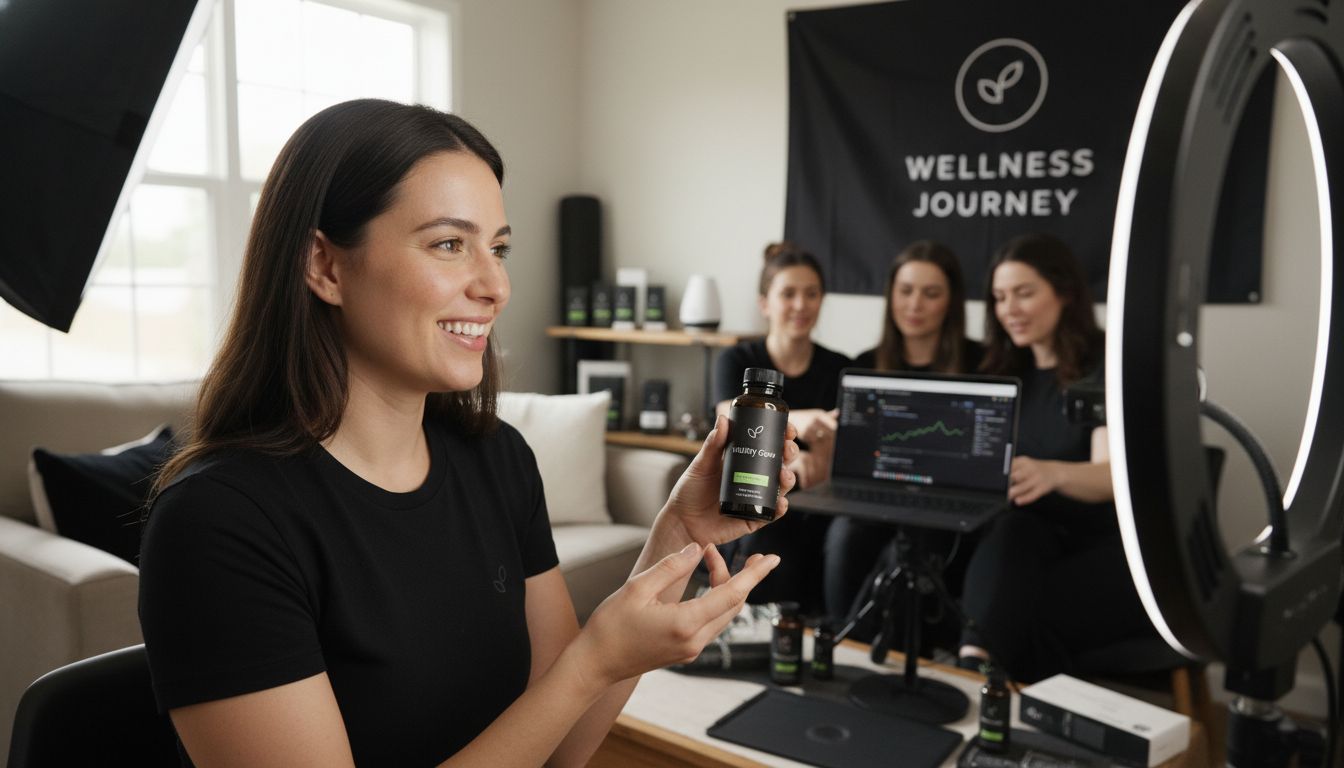Nearly 90 percent of marketers now use influencer collaborations to connect with their ideal customers and boost brand credibility. As people place more trust in social media personalities than in traditional ads, finding the right partnership has become a powerful tool for driving sales and building loyal communities. Understanding how to select influencers and measure real results can help brands avoid wasted budgets and reach audiences that truly care.
Table of Contents
- Defining Influencer Marketing Strategies
- Types of Influencers and Partnership Models
- How Influencer Campaigns Drive Results
- Choosing the Right Influencer for Your Brand
- Measuring ROI and Avoiding Pitfalls
Key Takeaways
| Point | Details |
|---|---|
| Influencer Marketing Defined | Brands leverage influencer popularity and credibility to drive customer engagement and sales, emphasizing authentic connections over traditional advertising. |
| Diverse Influencer Types | Various influencer types (nano to mega) offer unique engagement potentials; brands must choose based on their target audience’s characteristics. |
| Strategic Influencer Selection | Effective influencer partnerships require alignment of audience demographics, content authenticity, and shared brand values to establish meaningful connections. |
| ROI Measurement Strategies | Brands should apply nuanced analytical frameworks to measure campaign ROI beyond traditional metrics, incorporating engagement rates and brand sentiment evaluations. |
Defining Influencer Marketing Strategies
Influencer marketing represents a sophisticated digital strategy where brands collaborate with social media personalities to promote products, services, or messaging to targeted audiences. According to eprajournals.com, this approach leverages the popularity and credibility of influencers to positively impact customer acquisition and sales.
At its core, influencer marketing transcends traditional advertising by creating authentic connections between brands and consumers through trusted intermediaries. Key characteristics include strategic partnership selection, audience alignment, and measurable engagement metrics. As research from arxiv.org reveals, computational studies highlight critical aspects such as:
- Precise influencer identification strategies
- Advanced advertising approach development
- Comprehensive audience engagement techniques
- Regulatory compliance considerations
Successful influencer marketing strategies require deep understanding of both digital platforms and human psychology. Brands must carefully select influencers whose audience demographics, content style, and personal brand authentically match their marketing objectives. Social Media Marketing Strategies can provide additional context for integrating influencer approaches into broader digital marketing frameworks, ensuring a comprehensive and nuanced promotional strategy that resonates with target audiences.
Types of Influencers and Partnership Models
Influencer marketing encompasses diverse collaboration models ranging from micro-influencers to mega-influencers, each offering unique engagement potentials. According to so05.tci-thaijo.org, macro and mega-influencers demonstrate significant impact on customer loyalty, particularly in live streaming contexts, highlighting the strategic importance of selecting appropriate influencer tiers.
The primary influencer categories include:
Here’s a comparison of influencer types and their unique characteristics:
| Influencer Type | Follower Range | Audience Engagement | Typical Brand Impact |
|---|---|---|---|
| Nano-influencer | 1,000–10,000 | Very high, niche focus | Personalised connections |
| Micro-influencer | 10,000–50,000 | High, targeted groups | Authentic audience resonance |
| Mid-tier influencer | 50,000–500,000 | Balanced engagement | Broader reach, relatability |
| Macro-influencer | 500,000–1 million | Moderate-large scale | Significant brand exposure |
| Mega-influencer | 1 million+ | Broad, lower per user | Massive awareness, celebrity |
- Nano-influencers (1,000-10,000 followers): High engagement, niche audiences
- Micro-influencers (10,000-50,000 followers): Targeted, authentic connections
- Mid-tier influencers (50,000-500,000 followers): Balanced reach and relatability
- Macro-influencers (500,000-1 million followers): Broader audience exposure
- Mega-influencers (1 million+ followers): Massive reach, celebrity status
Research from research.polyu.edu.hk reveals sophisticated partnership models that transcend traditional sponsorship. These models focus on narrative strategies addressing potential challenges like content commercialization and transparency.
 Master Social Media Marketing for Beginners provides additional insights into developing effective influencer collaboration frameworks that maintain audience trust and brand authenticity.
Master Social Media Marketing for Beginners provides additional insights into developing effective influencer collaboration frameworks that maintain audience trust and brand authenticity.
How Influencer Campaigns Drive Results
Influencer marketing campaigns generate remarkable business outcomes by strategically leveraging digital engagement and targeted audience connections. According to arxiv.org, advanced data-driven approaches like InfluencerRank can precisely measure and optimize campaign effectiveness by analyzing posting behaviors and social relationships over time.
Key mechanisms driving campaign results include:
- Authentic storytelling: Creating genuine content that resonates
- Targeted reach: Accessing niche audience segments
- Social proof: Leveraging influencer credibility
- Engagement amplification: Generating interactive content experiences
- Trust building: Establishing meaningful brand connections
Research from arxiv.org reveals that specific video content features significantly impact audience engagement, particularly on platforms like YouTube. By understanding these nuanced interactions, brands can develop more sophisticated influencer strategies. Social Media Engagement Guide provides additional insights into creating compelling digital narratives that transform audience interactions into measurable marketing outcomes, ensuring influencer campaigns deliver tangible business results.
Choosing the Right Influencer for Your Brand
Selecting the perfect influencer requires a strategic, nuanced approach that goes beyond follower count. According to arxiv.org, advanced techniques like INFLECT-DGNN leverage Graph Neural Networks to predict influencer effectiveness by analyzing complex network interactions and temporal attributes, providing brands with data-driven selection insights.
Critical criteria for influencer selection include:
- Audience alignment: Demographic and psychographic match
- Content authenticity: Genuine engagement and brand resonance
- Performance metrics: Consistent interaction and conversion rates
- Value compatibility: Shared brand values and messaging
- Engagement quality: Depth of audience interaction
Research from arxiv.org highlights the InfluencerRank model, which evaluates influencers based on sophisticated metrics like posting behaviors and social relationships. Social Media Marketing Plan Template can help brands systematically approach influencer selection, ensuring a strategic approach that transforms potential partnerships into powerful marketing opportunities that drive meaningful audience connections.
Measuring ROI and Avoiding Pitfalls
Measuring return on investment (ROI) in influencer marketing demands sophisticated computational approaches that transcend traditional metrics. According to arxiv.org, comprehensive research emphasizes the critical need for nuanced analytical frameworks that incorporate contextual factors and improve model explainability when evaluating campaign performance.
Key ROI measurement strategies include:
- Engagement rate analysis: Tracking likes, comments, shares
- Conversion tracking: Monitoring direct and indirect sales impacts
- Brand sentiment evaluation: Assessing audience perception shifts
- Cost per engagement calculation: Determining economic efficiency
- Long-term brand awareness metrics: Measuring sustained influence
Research from arxiv.org introduces an interpretable deep learning framework demonstrating how specific video content features directly correlate with audience engagement metrics. Understanding Instagram Marketing Benefits can provide additional context for brands seeking to develop robust measurement strategies that mitigate common influencer marketing pitfalls and maximize potential returns through data-driven insights.
Unlock the Power of Influencer Marketing with Proven Strategies
Struggling to find the right influencers or build authentic connections with your target audience Can the complex digital landscape leave you overwhelmed by choices and unsure where to focus Influencer marketing is a game-changer when done right but it demands a strategic approach aligned with your business goals and audience needs. This guide dives into the challenges of selecting influencers, crafting engaging content, and measuring true ROI ensuring you avoid common pitfalls while tapping into powerful narrative and social proof techniques.
At Business Warriors, we understand the pain points faced by service-based businesses ready to scale their online marketing efforts. Our unique Marketing Vortex method weaves together expert insights from influencer identification to campaign optimization into an integrated, results-focused system. If you want to transform follower counts into genuine client relationships and reliable sales growth, it’s time to act.
Explore our insights in the Uncategorized Archives – Jarrod Harman and see how smart strategies can turn influencer marketing into a measurable asset.

Ready to stop guessing and start growing Leverage our proven Marketing Vortex method by visiting Jarrod Harman’s website to discover tailored solutions, client success stories, and actionable steps that can elevate your business now. Learn more about advancing your digital marketing at Business Warriors | Digital Marketing Agency and join a community passionate about taking marketing beyond the ordinary.
Frequently Asked Questions
What are the key characteristics of successful influencer marketing strategies?
Successful influencer marketing strategies include strategic partnership selection, audience alignment, and measurable engagement metrics. Brands need to choose influencers whose audience demographics and content style match their marketing objectives to create authentic connections.
How do I choose the right influencer for my brand?
To select the right influencer, consider audience alignment, content authenticity, performance metrics, value compatibility, and engagement quality. Advanced techniques like analysis of social relationships can help in evaluating influencers’ effectiveness.
What types of influencers are there and how do they differ?
Influencers can be categorized into five types: nano-influencers (1,000-10,000 followers), micro-influencers (10,000-50,000), mid-tier influencers (50,000-500,000), macro-influencers (500,000-1 million), and mega-influencers (1 million+). Each type offers distinct audience engagement levels and brand impact.

How can I measure the ROI of influencer marketing campaigns?
Measuring ROI in influencer marketing can be done through engagement rate analysis, conversion tracking, brand sentiment evaluation, cost per engagement calculation, and long-term brand awareness metrics. Comprehensive analytical frameworks can enhance the understanding of campaign performance.


